Abstract
We have examined the capacity of Legionella pneumophila membranes to induce cell-mediated immune responses and protective immunity in a guinea pig model of Legionnaires' disease. Guinea pigs immunized by aerosol with L. pneumophila membranes developed strong cell-mediated immune responses to L. pneumophila membranes as demonstrated by cutaneous delayed-type hypersensitivity and in vitro splenic lymphocyte proliferation. Guinea pigs immunized by aerosol or by subcutaneous inoculation with L. pneumophila membranes developed strong protective immunity against lethal aerosol challenge with L. pneumophila. Overall, in six independent experiments, 39 of 49 (80%) guinea pigs immunized with L. pneumophila membranes survived challenge compared with 2 of 40 (5%) sham-immunized controls (P = 2 x 10(-13). In contrast, guinea pigs immunized by aerosol with formalin-killed L. pneumophila did not develop either a strong cell-mediated immune response to L. pneumophila antigens or protective immunity to lethal aerosol challenge. The capacity of L. pneumophila membranes to induce protective immunity was independent of the major secretory protein of L. pneumophila, which we previously demonstrated is an immunoprotective molecule. Purified L. pneumophila membranes did not contain detectable major secretory protein (MSP) on immunoblots; immunization of guinea pigs with L. pneumophila membranes did not induce anti-MSP antibody; and guinea pigs developed comparable protective immunity after immunization with membranes from either an L. pneumophila strain that secretes the major secretory protein or an isogenic mutant that does not. This study demonstrates that (a) immunization with L. pneumophila membranes but not formalin-killed L. pneumophila induces strong cell-mediated immune responses and protective immunity, (b) L. pneumophila membranes contain immunoprotective molecules distinct from the major secretory protein of L. pneumophila, and (c) L. pneumophila membranes have potential as a vaccine against Legionnaires' disease.
Full text
PDF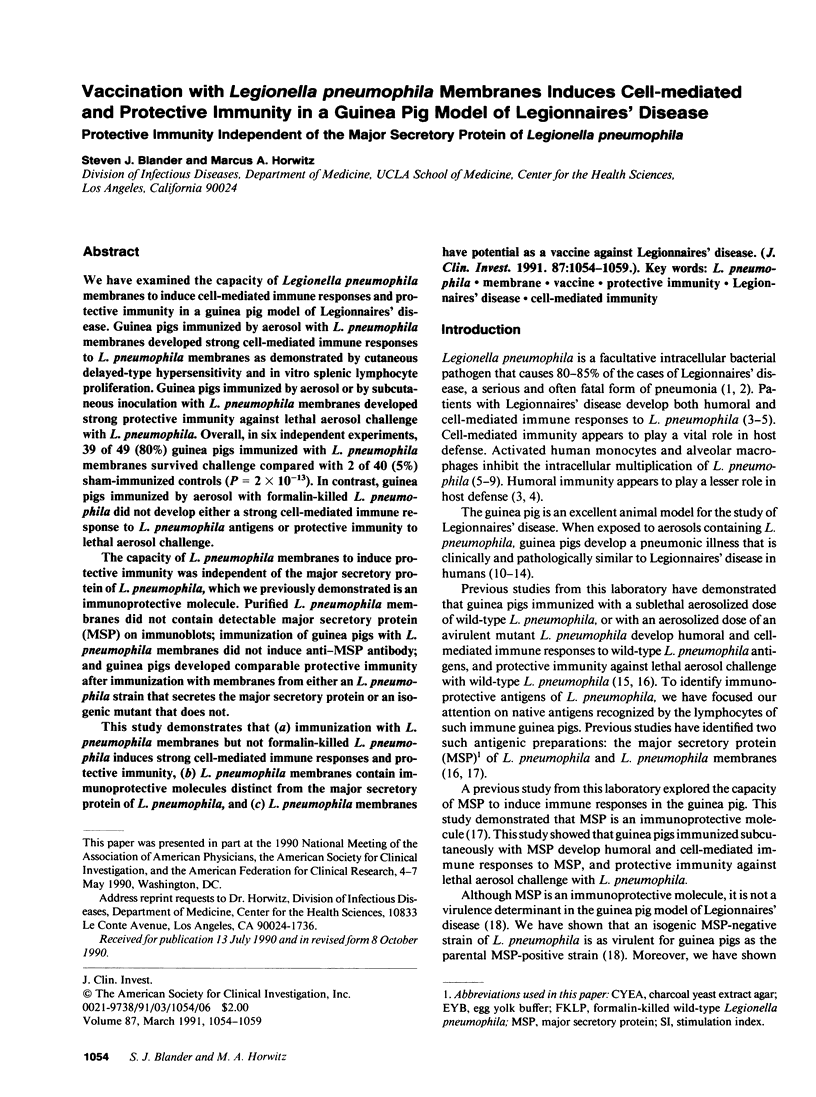
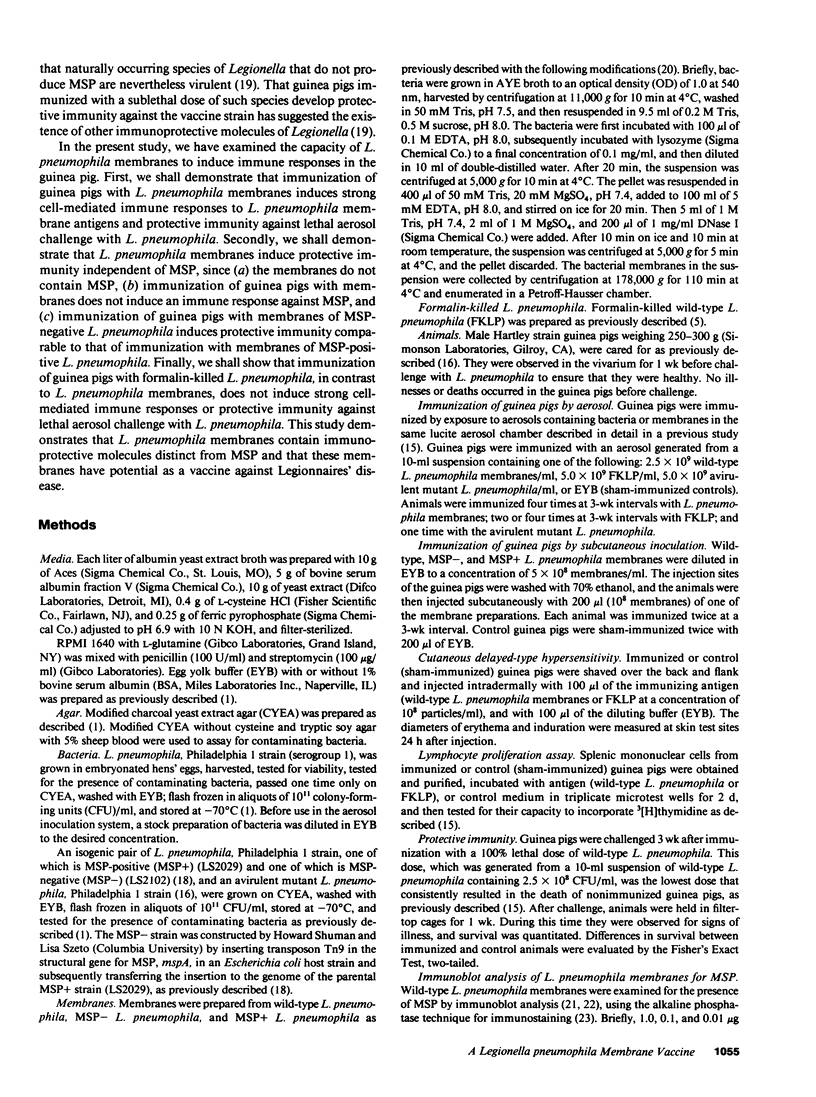
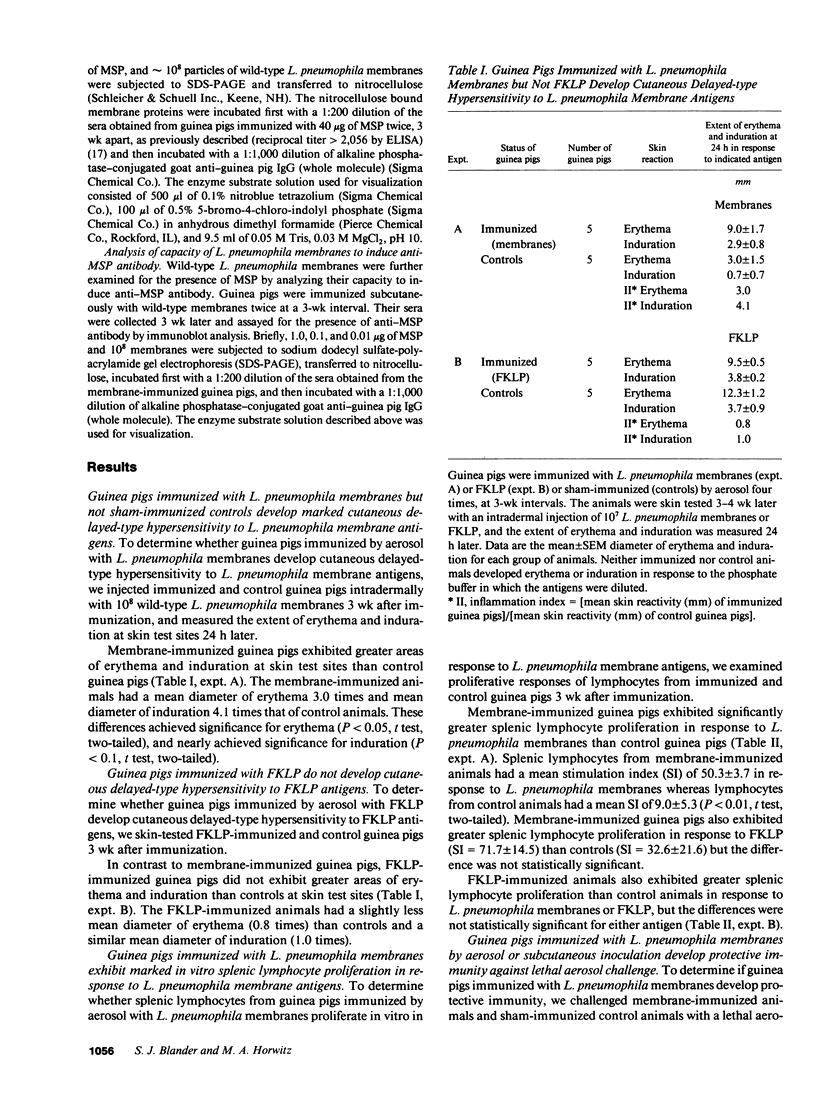
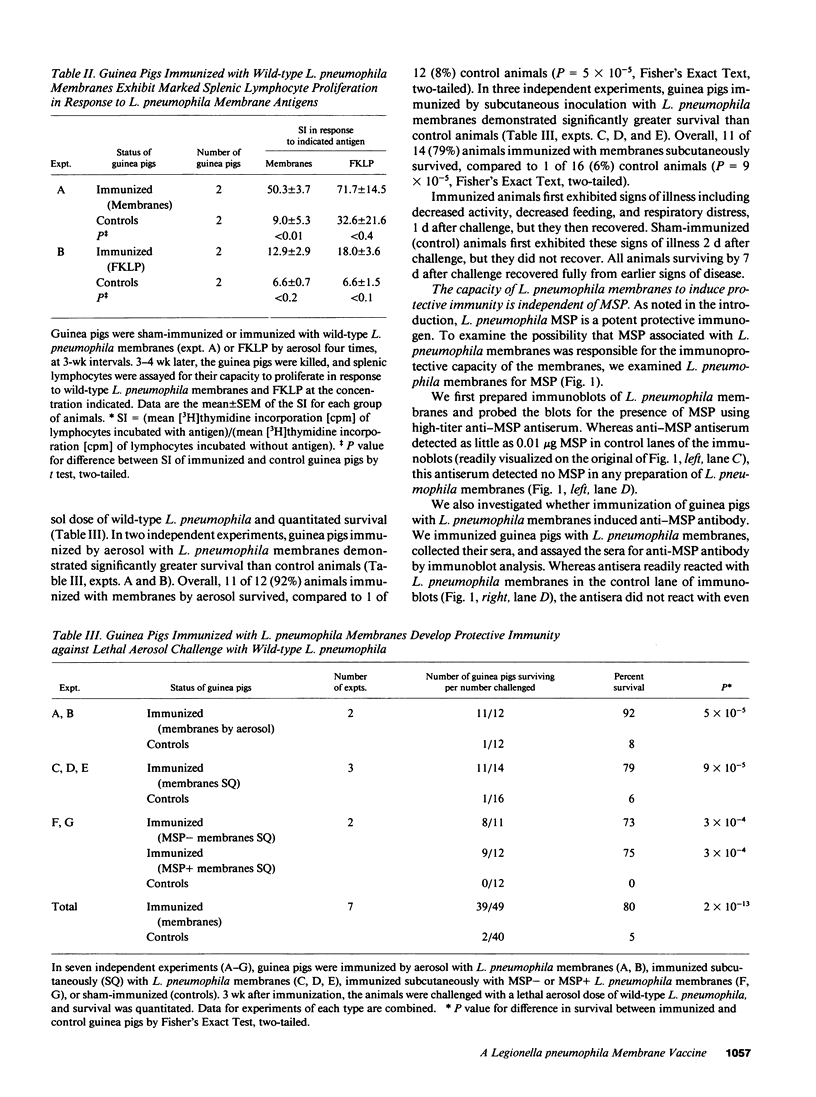
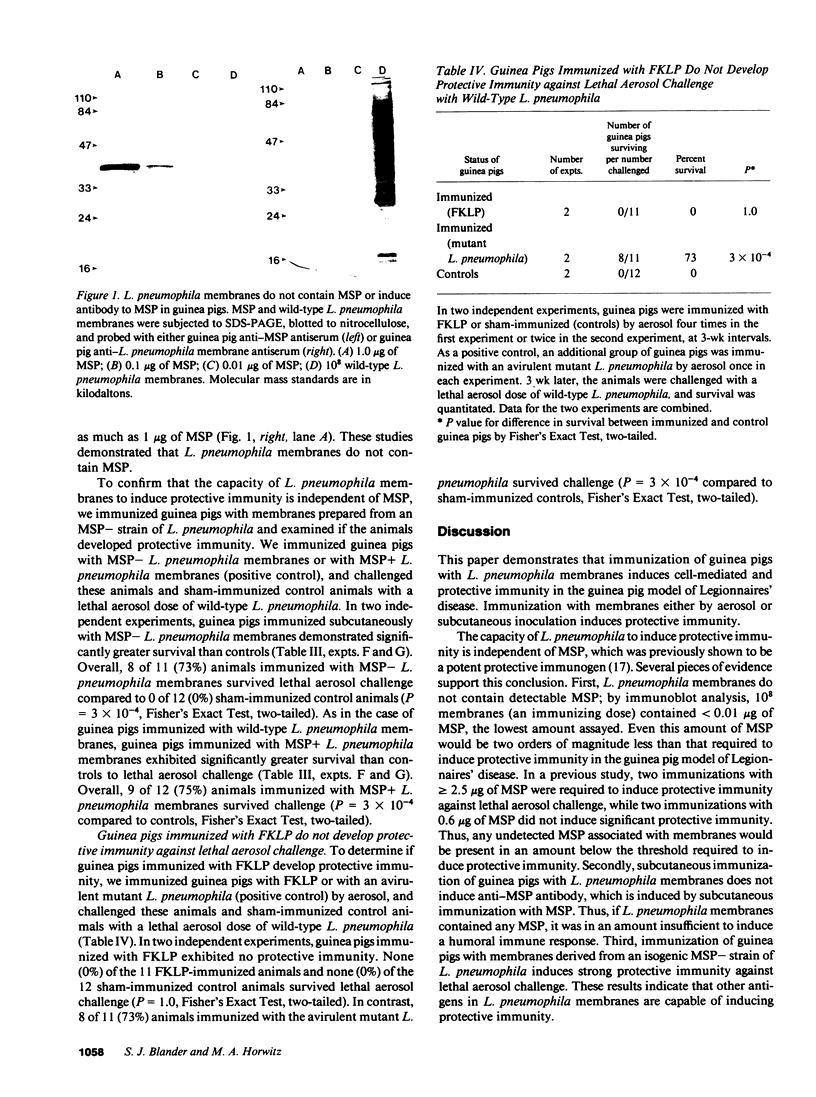
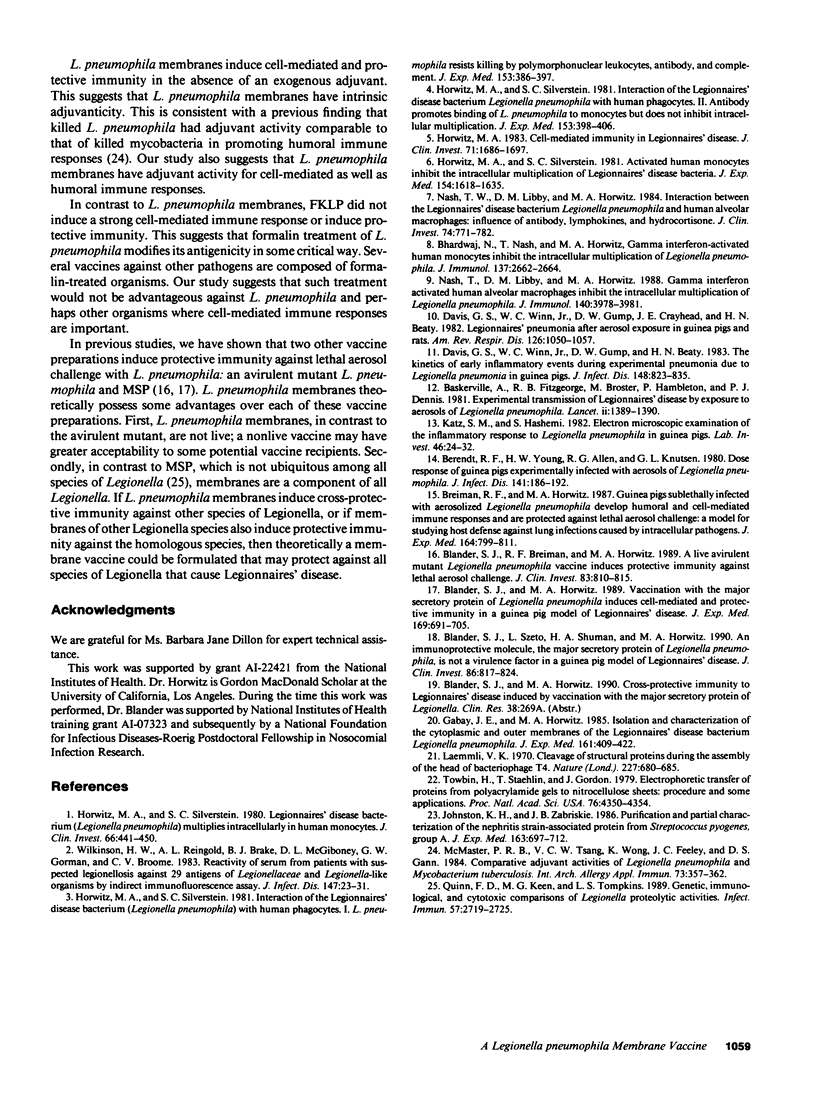
Images in this article
Selected References
These references are in PubMed. This may not be the complete list of references from this article.
- Baskerville A., Fitzgeorge R. B., Broster M., Hambleton P., Dennis P. J. Experimental transmission of legionnaires' disease by exposure to aerosols of Legionella pneumophila. Lancet. 1981 Dec 19;2(8260-61):1389–1390. doi: 10.1016/s0140-6736(81)92803-8. [DOI] [PubMed] [Google Scholar]
- Berendt R. F., Young H. W., Allen R. G., Knutsen G. L. Dose-response of guinea pigs experimentally infected with aerosols of Legionella pneumophila. J Infect Dis. 1980 Feb;141(2):186–192. doi: 10.1093/infdis/141.2.186. [DOI] [PubMed] [Google Scholar]
- Blander S. J., Breiman R. F., Horwitz M. A. A live avirulent mutant Legionella pneumophila vaccine induces protective immunity against lethal aerosol challenge. J Clin Invest. 1989 Mar;83(3):810–815. doi: 10.1172/JCI113962. [DOI] [PMC free article] [PubMed] [Google Scholar]
- Blander S. J., Horwitz M. A. Vaccination with the major secretory protein of Legionella pneumophila induces cell-mediated and protective immunity in a guinea pig model of Legionnaires' disease. J Exp Med. 1989 Mar 1;169(3):691–705. doi: 10.1084/jem.169.3.691. [DOI] [PMC free article] [PubMed] [Google Scholar]
- Blander S. J., Szeto L., Shuman H. A., Horwitz M. A. An immunoprotective molecule, the major secretory protein of Legionella pneumophila, is not a virulence factor in a guinea pig model of Legionnaires' disease. J Clin Invest. 1990 Sep;86(3):817–824. doi: 10.1172/JCI114779. [DOI] [PMC free article] [PubMed] [Google Scholar]
- Breiman R. F., Horwitz M. A. Guinea pigs sublethally infected with aerosolized Legionella pneumophila develop humoral and cell-mediated immune responses and are protected against lethal aerosol challenge. A model for studying host defense against lung infections caused by intracellular pathogens. J Exp Med. 1987 Mar 1;165(3):799–811. doi: 10.1084/jem.165.3.799. [DOI] [PMC free article] [PubMed] [Google Scholar]
- Davis G. S., Winn W. C., Jr, Gump D. W., Beaty H. N. The kinetics of early inflammatory events during experimental pneumonia due to Legionella pneumophila in guinea pigs. J Infect Dis. 1983 Nov;148(5):823–835. doi: 10.1093/infdis/148.5.823. [DOI] [PubMed] [Google Scholar]
- Davis G. S., Winn W. C., Jr, Gump D. W., Craighead J. E., Beaty H. N. Legionnaires' pneumonia after aerosol exposure in guinea pigs and rats. Am Rev Respir Dis. 1982 Dec;126(6):1050–1057. doi: 10.1164/arrd.1982.126.6.1050. [DOI] [PubMed] [Google Scholar]
- Gabay J. E., Horwitz M. A. Isolation and characterization of the cytoplasmic and outer membranes of the Legionnaires' disease bacterium (Legionella pneumophila). J Exp Med. 1985 Feb 1;161(2):409–422. doi: 10.1084/jem.161.2.409. [DOI] [PMC free article] [PubMed] [Google Scholar]
- Horwitz M. A. Cell-mediated immunity in Legionnaires' disease. J Clin Invest. 1983 Jun;71(6):1686–1697. doi: 10.1172/JCI110923. [DOI] [PMC free article] [PubMed] [Google Scholar]
- Horwitz M. A., Silverstein S. C. Activated human monocytes inhibit the intracellular multiplication of Legionnaires' disease bacteria. J Exp Med. 1981 Nov 1;154(5):1618–1635. doi: 10.1084/jem.154.5.1618. [DOI] [PMC free article] [PubMed] [Google Scholar]
- Horwitz M. A., Silverstein S. C. Interaction of the Legionnaires' disease bacterium (Legionella pneumophila) with human phagocytes. I. L. pneumophila resists killing by polymorphonuclear leukocytes, antibody, and complement. J Exp Med. 1981 Feb 1;153(2):386–397. doi: 10.1084/jem.153.2.386. [DOI] [PMC free article] [PubMed] [Google Scholar]
- Horwitz M. A., Silverstein S. C. Interaction of the legionnaires' disease bacterium (Legionella pneumophila) with human phagocytes. II. Antibody promotes binding of L. pneumophila to monocytes but does not inhibit intracellular multiplication. J Exp Med. 1981 Feb 1;153(2):398–406. doi: 10.1084/jem.153.2.398. [DOI] [PMC free article] [PubMed] [Google Scholar]
- Horwitz M. A., Silverstein S. C. Legionnaires' disease bacterium (Legionella pneumophila) multiples intracellularly in human monocytes. J Clin Invest. 1980 Sep;66(3):441–450. doi: 10.1172/JCI109874. [DOI] [PMC free article] [PubMed] [Google Scholar]
- Johnston K. H., Zabriskie J. B. Purification and partial characterization of the nephritis strain-associated protein from Streptococcus pyogenes, group A. J Exp Med. 1986 Mar 1;163(3):697–712. doi: 10.1084/jem.163.3.697. [DOI] [PMC free article] [PubMed] [Google Scholar]
- Katz S. M., Hashemi S. Electron microscopic examination of the inflammatory response to Legionella pneumophila in guinea pigs. Lab Invest. 1982 Jan;46(1):24–32. [PubMed] [Google Scholar]
- Laemmli U. K. Cleavage of structural proteins during the assembly of the head of bacteriophage T4. Nature. 1970 Aug 15;227(5259):680–685. doi: 10.1038/227680a0. [DOI] [PubMed] [Google Scholar]
- McMaster P. R., Tsang V. C., Wong K. H., Feeley J. C., Gann D. S. Comparative adjuvant activities of Legionella pneumophila and Mycobacterium tuberculosis. Int Arch Allergy Appl Immunol. 1984;73(4):357–362. doi: 10.1159/000233498. [DOI] [PubMed] [Google Scholar]
- Nash T. W., Libby D. M., Horwitz M. A. IFN-gamma-activated human alveolar macrophages inhibit the intracellular multiplication of Legionella pneumophila. J Immunol. 1988 Jun 1;140(11):3978–3981. [PubMed] [Google Scholar]
- Nash T. W., Libby D. M., Horwitz M. A. Interaction between the legionnaires' disease bacterium (Legionella pneumophila) and human alveolar macrophages. Influence of antibody, lymphokines, and hydrocortisone. J Clin Invest. 1984 Sep;74(3):771–782. doi: 10.1172/JCI111493. [DOI] [PMC free article] [PubMed] [Google Scholar]
- Quinn F. D., Keen M. G., Tompkins L. S. Genetic, immunological, and cytotoxic comparisons of Legionella proteolytic activities. Infect Immun. 1989 Sep;57(9):2719–2725. doi: 10.1128/iai.57.9.2719-2725.1989. [DOI] [PMC free article] [PubMed] [Google Scholar]
- Towbin H., Staehelin T., Gordon J. Electrophoretic transfer of proteins from polyacrylamide gels to nitrocellulose sheets: procedure and some applications. Proc Natl Acad Sci U S A. 1979 Sep;76(9):4350–4354. doi: 10.1073/pnas.76.9.4350. [DOI] [PMC free article] [PubMed] [Google Scholar]
- Wilkinson H. W., Reingold A. L., Brake B. J., McGiboney D. L., Gorman G. W., Broome C. V. Reactivity of serum from patients with suspected legionellosis against 29 antigens of legionellaceae and Legionella-like organisms by indirect immunofluorescence assay. J Infect Dis. 1983 Jan;147(1):23–31. doi: 10.1093/infdis/147.1.23. [DOI] [PubMed] [Google Scholar]



